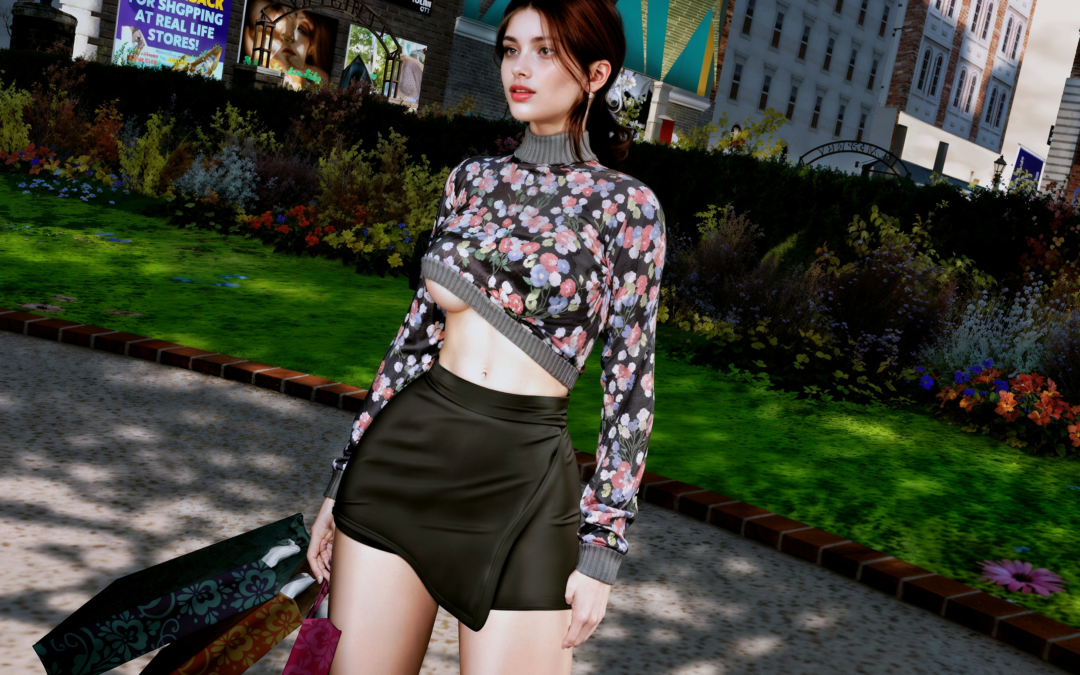Inspired by Prisqua’s article on Slex and the City, I felt compelled to delve deeper into the struggles faced by fashion designers in Second Life. As a creator of original mesh clothing, I experience firsthand the complexities of this virtual market. This article aims to share my personal reflections and extend the discussion on the intricate balance between creativity and economic sustainability.
The Creative Process: From Modeling to Promotion
Modeling and Rigging: A Precision Task
Creating original mesh clothing in Second Life starts with the intricate process of 3D modeling. Using advanced software like Blender, Zbrush, and Marvelous Designer, I sculpt the garment, ensuring it is both realistic and aesthetically pleasing. The next step, rigging, is crucial for ensuring the clothing fits and moves naturally with the avatar, requiring meticulous attention to detail to avoid distortions.
Texturing: Bringing Designs to Life
Once modeling and rigging are complete, I move on to texturing. This step involves adding colors, patterns, and details that bring the garment to life. Using tools like Photoshop and Substance Painter, I painstakingly create textures that enhance the visual appeal and uniqueness of each piece, ensuring they stand out in a crowded marketplace.
Vendor Creation and Promotion: Marketing Mastery
Creating the product is only half the battle. Next comes designing vendors—virtual displays that effectively showcase my items. These need to be visually striking and informative to attract potential buyers. Additionally, promoting my creations through social media, blogs, and Second Life groups is vital. This continuous effort requires strategic planning and consistent engagement to maintain customer interest and drive sales.
The Pressure of Shopping Events: A Necessity?
Participating in Events: Opportunities and Pressures
Shopping events have become essential for visibility and sales. However, they bring immense pressure. Frequent deadlines force creators to prioritize quantity over quality at times, recycling ideas to keep up with the demand. This relentless pace can stifle creativity and compromise the originality of designers.
The Incessant Cycle of Events: A Strain on Creativity
With shopping events occurring monthly or even weekly, the pressure to produce new content is constant. This leaves little room for innovation, as I must meet the rapid turnaround times. The stress of keeping up with this cycle often results in creative burnout, making it challenging to maintain the high standards I aspire to. For this reason, I actually stopped participating in almost any events.
The Challenge of Low Prices: Is It Sustainable?
Weekend Events: Undercutting Full-Price Sales
One of the most significant challenges is the proliferation of weekend events offering steep discounts (50-70 L$). These attract consumers looking for bargains, significantly impacting sales at full-price events. This trend could potentially harm the economic sustainability of creators’ businesses because the reduced prices do not accurately reflect the effort and resources invested in creating high-quality items.
The Role of Weekend Events: Innovation and Market Balance
Weekend events in Second Life play a crucial role by offering innovative and affordable shopping experiences, making them highly attractive to consumers. They provide an opportunity for shoppers to explore new products at discounted prices, driving traffic and engagement. However, it’s essential to manage these events carefully to avoid undermining the traditional market. Setting boundaries on the frequency and extent of discounts can help maintain a healthy balance, ensuring that creators can sustain their businesses while still benefiting from the exposure and excitement that weekend events generate. This balance preserves the value of high-quality creations and supports a vibrant, sustainable economy within Second Life.
Economic Sustainability: A Daily Dilemma
I am struggling with the key question of whether this business model is actually sustainable. Selling at low prices reduces my profit margins, despite the significant time and effort required to produce each item. The intense competition and consumer expectations for low prices challenge my ability to maintain a financially viable operation. I constantly reevaluate my marketing strategies to find a balance between event participation and product quality.

Strategies for the Future: Innovation and Cooperation
Collaboration Between Creators and Event Organizers
A potential solution to these challenges is fostering greater collaboration between creators and event organizers. By working together, we could develop methods to better showcase high-quality work without sacrificing profit. For example, events could highlight premium products and encourage consumers to appreciate the craftsmanship involved, thus supporting fair pricing.
Diversifying Marketing Strategies
Another strategy is to diversify promotional and sales channels. Beyond shopping events, establishing permanent in-world stores and leveraging online marketplaces can help reduce dependency on events. This approach provides greater control over pricing and quality, ensuring a more stable and sustainable business model.
Consumer Education: Valuing Creative Work
Educating consumers about the value of our work is crucial. Awareness campaigns that highlight the creation process and the skills required to produce original mesh clothing can foster greater appreciation for high-quality items. This, in turn, can lead to a willingness to pay higher prices for unique, well-crafted products, supporting the sustainability of our creative endeavors.
Leveraging In-World Groups to Drive Store Traffic in Second Life
In-world groups in Second Life are a powerful tool for increasing store traffic and boosting in-store sales. By joining and actively participating in relevant groups, creators can directly engage with a targeted audience interested in their products. Announcements about new releases, special promotions, and exclusive group gifts can be shared within these groups, creating buzz and encouraging visits to the store. Additionally, forming your own group allows for direct communication with loyal customers, fostering a community around your brand and enhancing customer loyalty and retention.
Conclusion: Balancing Creativity and Sustainability
Being an original mesh clothing creator in Second Life is a rewarding yet challenging endeavor. The pressures of shopping events and the trend towards low prices pose significant obstacles. However, through innovation, cooperation, and consumer education, we can find a balance between maintaining our creative integrity and ensuring economic sustainability. By continuing to innovate and experiment while staying mindful of financial realities, we can achieve long-term success in the virtual world of Second Life.
Sharing my experiences and insights aims to help other creators navigate these challenges and find their path to success. Second Life offers a unique platform for creativity and business, and with the right strategies, we can continue to thrive and realize our dreams.
Sign up for our newsletter now!









